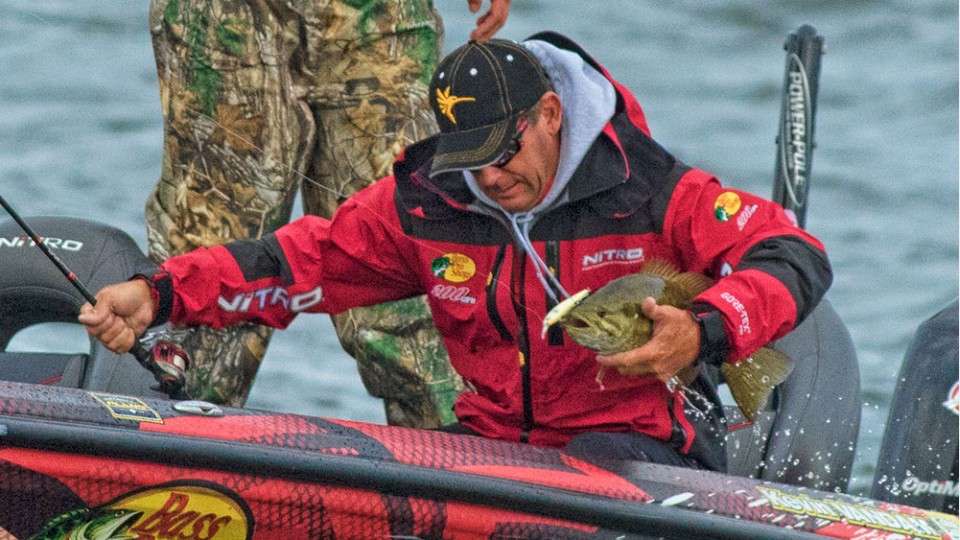
I love to catch bass, no matter whether it’s in the north, south, east or west. I don’t care if I’m catching largemouth, smallmouth or spotted bass — I love ‘em all.
But, when it comes October, there’s nothing I’d rather be fishing than smallmouth on my home Michigan waters.
This is where you can catch numbers of quality fish and the true smallmouth bass of a lifetime with power fishing tactics. Smallies are aggressive this time of year and will knock the rod out of your hands when you get around them.
Sure, you can catch them on finesse tactics, but fall smallmouth move a lot and are very condition-oriented, capitalizing on feeding opportunities based upon the weather and water at any given time. You have to cover water fast, and they’re generally aggressive enough to hit whatever fast movers you throw at them.
They tend to be 10 feet of water or less and gorging on a specific type of forage. In fact, you may find northern smallies feeding shallower now than at any other time of the year.
They know the days are getting shorter and the water is cooling fast. Winter is approaching, so they are packing on pounds.
But here’s the thing —northern lakes have a variety of forage, and bass will target whatever is most available to them at that time. They are extremely opportunistic and their preferences can change daily.
If you catch fish and put them in the livewell, notice what type of forage they may be regurgitating. That can clue you into lure color to use and depth zone you need to be targeting.
One of the first things I do when I get to the lake is assess the water clarity. Clarity determines the strike zone and type of lure I need to use. The preferred forage and clarity can dictate how deep the bass will be and therefore where they are feeding.
If they are eating bottom-dwelling forage (perch, crawfish or gobies, for example) on a 20-foot-deep sand grass line, it’s difficult to get them to chase a spinnerbait fished under the surface. That’s when a deep jerkbait or crankbait is better. On the other hand, if there’s an algae bloom with only five feet of visibility or a lot of wind, that will put the fish shallower, and a big, flashy spinnerbait is a better choice.
Weather conditions are a factor, too. Unlike largemouth, northern smallmouth tend to be more aggressive on sunny rather than cloudy days because they are sight feeders. That sunshine also helps you find some of the subtle spots they will use, such as cover, drops, sandbars and weed edges. When the water is clear, you can see better and make more proficient casts.
However, keep in mind that smallmouth don’t need a lot of cover to feed. It can be as simple as a patch of gravel, a mossy spot on the bottom, or a single log or stick lying on a flat.
Transitional areas are best, such as where rock changes to gravel or where gravel ends on a clean, sandy bottom. They rarely like sharp dropoffs and prefer to roam flats, whether it’s shallow along the bank or a deep flat that butts against a drop off.
Wind is critical. It creates current, activates the bait and pushes smallmouth shallower, even on the clearest lakes. Perfect conditions would be sunny with a 15 mph wind; that can make it difficult moving around, but it also energizes the smallmouth.
Remember: This is one time of year you have put the trolling motor down and cover a lot of water. Because they move often, you have to dial into precisely what the fish are using on any given day. They could be relating to sandbars, rocky points, cabbage weeds or deep sand grass.
And remember this about lure selection —the clearer the water, the more important natural colors become, especially when fishing down in the water column, such as with crankbaits and Red Eye Shads. It’s less important when fishing over the top of the fish.
I use natural colors that best match the forage, yet they must be visible to the fish. If there’s a stain to the water, you can brighten up your colors.
In fact, if the bite is wide open and the fish are real aggressive, I’ll go to chartreuse spinnerbait blades, even in gin clear water. In most situations, though, natural colors work best.
If big smallmouth are on your bucket list, arm yourself with some fast-moving baits, pack some warm clothes and head north. Your chances of catching giant smallmouth are best right now!
Originally published in October 2013.





